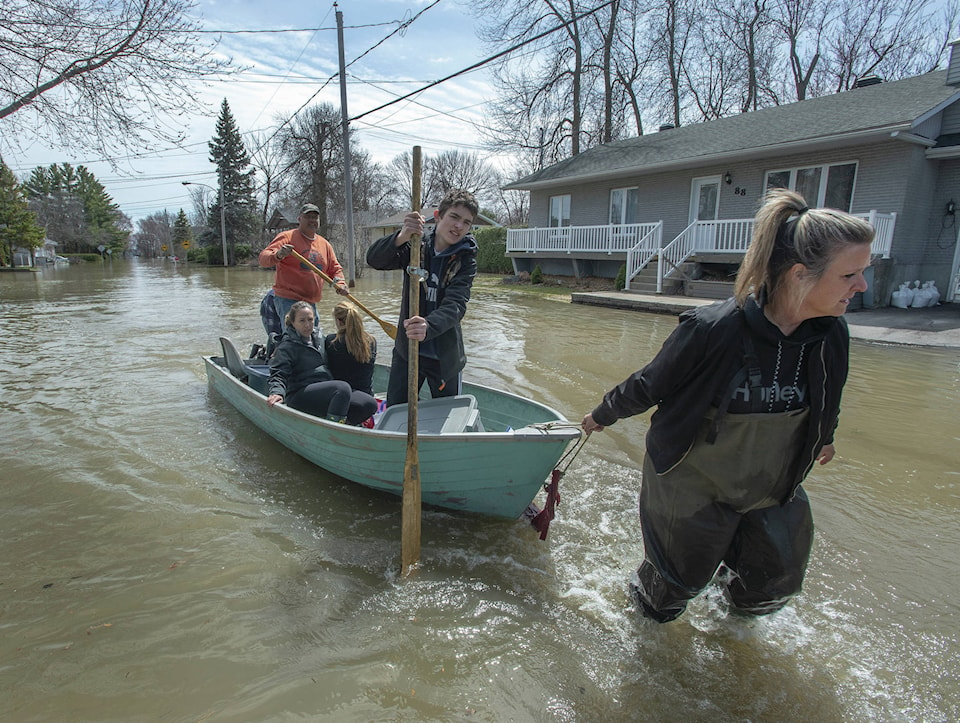STE-MARTHE-SUR-LE-LAC, Que. — Robert Pepin’s mobile home sits crookedly on its foundation, the front door is broken, the insulation and deck are damaged beyond repair.
But the 70-year-old resident of Ste-Marthe-sur-le-Lac, Que., says he’s happy and less anxious because he’s been able to visit his home and see what the water did to it.
“(Before) there was so much pressure in your head,” Pepin said. “You think all the time, you can’t sleep. What am I going to do, is my house finished? Now you see what’s there, and you deal with it.”
Over the weekend water from the Lake of Two Mountains breached a dike and rushed through the Montreal suburb, forcing Pepin and about 6,000 others from their homes. On Tuesday, residents of 1,485 homes that were spared the flooding were cleared to return home, though authorities said they would be without running water or electricity for an indefinite period.
The partial lifting of the evacuation was a rare glimmer of hope in a province that has been fighting flooding for two weeks. “The worst is behind us,” Public Security Minister Genevieve Guilbault said earlier in the day.
Some 2,500 soldiers remain stationed in flood-ravaged regions of New Brunswick, Quebec and Ontario, and various communities have declared a state of emergency. As Quebec and New Brunswick saw improvement on the horizon, in Ontario the situation was “potentially worsening,” federal Public Safety Minister Ralph Goodale said Tuesday
So far about 1,600 people have been forced from their homes across Ontario, Goodale said, most of whom are from the northern First Nations territory of Kashechewan.
City officials in Ottawa Tuesday said the bloated Ottawa River and its tributaries are expected to rise “over the next several days.” At an afternoon briefing, officials said they were closing a street through the heart of the flood-affected area of Constance Bay and asking 150 households to voluntarily evacuate.
The river is already 30 centimetres above the peak levels of severe flooding in 2017, and could go up another 20 centimetres depending on the weather in the coming days. Forecasts call for snow, ice pellets and freezing rain, followed by up to 40 millimetres of rain by Thursday morning.
“The worst is yet to come,” Ottawa Mayor Jim Watson said.
In New Brunswick, the province’s director of emergency measures, Greg MacCallum, said Tuesday the response to this year’s spring flooding is slowly turning into a recovery operation.
“Most regions along the Saint John River should be out of the flood stage by the end of this week,” he said. He said water levels along most of the river are making a slow but steady decline.
Bill Lawlor, the New Brunswick director of the Canadian Red Cross, said while some people have begun returning to their homes, the agency is still housing 433 people in hotels.
Goodale said about 9,200 residences and cottages remain flooded in New Brunswick along with 7,000 other properties of different kinds.
Earlier on Tuesday, Prime Minister Justin Trudeau said investments in climate-resilient infrastructure and mitigation measures will be needed in the fight against climate change.
“We recognize that there is an increasing reality that, almost every year, we’re dealing with people having to evacuate their homes, protect their homes from rising floodwaters,” Trudeau told reporters. “These extreme weather events are going to happen more often.”
